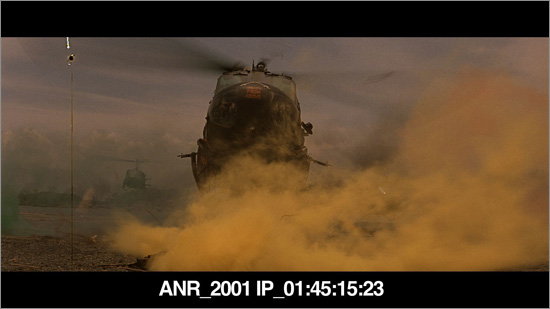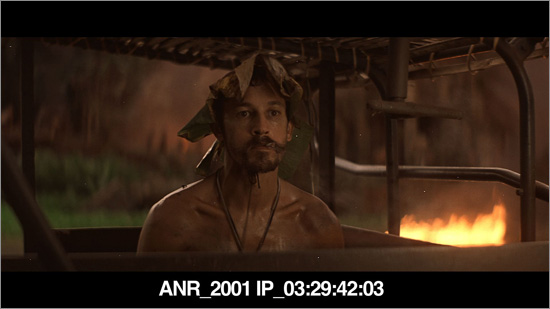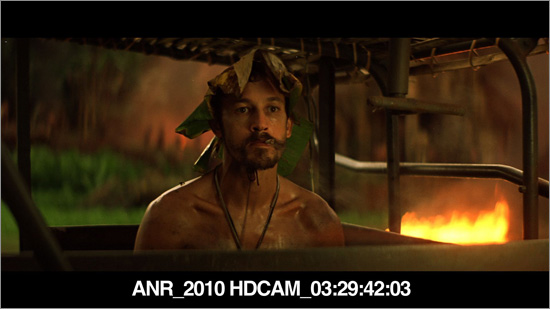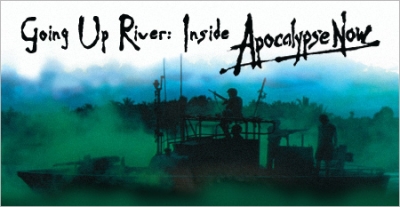When Lionsgate recently announced their new 3-disc Full Disclosure Blu-ray Edition of Francis Ford Coppola's legendary Vietnam War film, Apocalypse Now, the news seemed almost too good to be true for longtime fans. The set, which streets on 10/19, is due to include both versions of the film, many hours of bonus features and, at long last, the infamous Hearts of Darkness documentary – the first time the film and documentary have ever been presented together on disc. It also includes – for the first time in ANY home format – both versions of the film in their original 2.35:1 theatrical aspect ratio. Given the film's complex history, and the equally complicated history of its past home video editions, fans of Apocalypse Now immediately began to have questions about the Blu-ray release, and quickly began to speculate about the release online. How would the new transfer compare to the 2001 release? How involved were Coppola and cinematographer Vittorio Storaro in preparing the new transfer? What surprises might the new edition bring?
To answer some of these questions, the production team at Lionsgate Home Entertainment and Coppola's American Zoetrope were kind enough to talk with The Digital Bits for nearly an hour last week. Participating were Lionsgate's Senior VP of DVD and Blu-ray Production, Miguel Casillas, and Zoetrope film archivist James Mockoski (who supervised the new restoration of the film), along with colorist Doug Delaney and Jay Miracle, the editor of the Hearts of Darkness documentary (he also worked on the original Apocalypse Now). What follows is a transcript of that conversation. We hope you'll enjoy it!
---
Bill Hunt (The Digital Bits): We might as well start off right away by talking about the issue that – I don't know if controversial is the right word, but it's certainly the most talked about issue related to the home video releases of Apocalypse Now, which is the aspect ratio. All of the previous DVD versions have presented the film in the 2.00:1 aspect ratio preferred by cinematographer Vittorio Storaro. On the other hand, the film was originally shot and presented theatrically in the 2.35:1 ratio. So how was the decision made to go 2.35 at long last for this Blu-ray release?
James Mockoski (American Zoetrope): This is a decision that Francis and Vittorio made together back in 2001 – to offer the 2.00:1. Francis very much supported – and still supports – Vittorio's vision of 2:1. It's not just a widescreen issue. It's well publicized on Vittorio's website how he thinks film should be presented. It goes back to Leonardo da Vinci, and he has a whole philosophy about looking at artwork in 2:1. Honestly, if we could, we would have included a 2:1 version on the Blu-ray along with the 2.35:1. Of course, people have wanted the 2.35:1, so we wanted to include that, but we don't discount what Vittorio did either. And we had a long discussion with Lionsgate about how we could do both. But Francis has certain specifications about this release that he wanted. One of the criticisms of the last release was that the film was broken up over two discs. So this time, we wanted to offer both Redux and the original cut on one disc. That meant [for disc space reasons] we had to choose: 2.35 or 2:1. We just couldn't have both, which Francis wanted. So we chose 2.35 because it was the original aspect ratio of the film.
Bill Hunt: It's fascinating to me that there's a completely valid artistic argument to be made for both aspect ratios. It wasn't just some arbitrary decision to go 2:1 originally.
James Mockoski: I know. Miguel and I talked for hours about this. Vittorio would still argue that 2:1 is a valid thing to do for widescreen presentation. He has a whole philosophy about how people view films, and he feels that 2:1 gives them the best presentation of a film.
Miguel Casillas (Lionsgate): And James, I think we had also spoken at one point about the whole advent of a 16x9, widescreen monitor world, which might not have been as prevalent back in 2001 but certainly is now. If you believe in the philosophy that Blu-ray offers the best verbatim reproduction of a theatrical experience, then that's one advantage of doing the 2.35 on the Blu-ray, along with the fact that it hadn't been done before. And if you could hearken back to how audiences would have seen Apocalypse Now back in 1979, it would have been in this visual presentation.
Bill Hunt: Certainly, judging by the feedback of the film's fans, 2:35 is definitely what they've wanted to see for a long time. On the subject of the visual presentation, can you guys talk about the new transfers of the films? Specifically, the restoration work that was involved in creating the Blu-ray master, and what might be different or improved from 2001 to now?
James Mockoski: Sure, I can walk you through the steps of how we got it to mastering, and Doug can talk about the color. We chose the inter-positive of Apocalypse Now Redux and had it transferred at 4K. That gave us the best quality to start with, because the original negative had suffered damage over the years. And Doug and iO Films had it down converted to 2K so they could work in color.
Bill Hunt: Now, I know that the original elements for the theatrical cut were essentially taken apart and repurposed for Redux, so how was that version handled?
James Mockoski: Basically, for Redux, about 45 minutes of footage was added, in addition to the theatrical cut. There's a slight difference in edits, but basically it was just an insertion of additional footage in 2001. So the theatrical cut of Apocalypse Now is there in the I.P. of Redux. So we took the I.P. transfer and, using seamless branching on Blu-ray, it just skips over the added footage to present the 1979 cut.
Bill Hunt: So both versions are sourced from the same 4K transfer.
James Mockoski: Yes.
Comparison of the 2001 I.P. (top) and 2010 Blu-ray master (bottom).


Bill Hunt: Looking at the screenshot comparisons you guys provided between the 2001 master and the new 2010 master, there's a marked difference in the color-timing. Color seems more vibrant now, and contrasts are bolder. Can you talk about that? How those decisions were made and what the differences might be?
Doug Delaney: Sure, I can touch on that and James can chime in. One of the original conversations we began to have when we started looking at doing this work, was using the original transfer in 2001 as a reference – as indicative of the best possible transfer at the time, using that technology, and with a lot of time spent with Vittorio on that original transfer. We also screened – myself, James and Mr. Coppola – the dye-transfer print as well. And we wanted to get back to that in terms of not just aspect ratio, but the contrast and color saturation characteristics of a dye-transfer print in terms of its natural rendition – to be a little bit more, I guess, faithful to that original projection of that dye-transfer print. To get to that point, there was a little bit of negotiation between using both sources as inspiration, I guess is the best way I could put it, between that beautiful dye-transfer print Mr. Coppola had as well as honoring the time and quality of the transfer in '01 that obviously had Vittorio's time put into it. Some scenes tended to carry over very well with regard to the two transfers, and some scenes felt more akin to the dye-transfer print.
Bill Hunt: So in other words, the goal was to get as close to that original dye-transfer presentation as possible, but still have it informed by Francis and Vittorio's 2001 work and the improvements over time.
Doug Delaney: Yes, I say that's it.
James Mockoski: You know, Vittorio has always been a lover of Technicolor. And what Redux allowed us to do in 2001 was, Technicolor brought back the machine and installed it – that replicated that Technicolor process. I think Bulworth was the first film off that machine, and Redux was the second. But it allowed Vittorio to have that great saturation of colors and deep, deep blacks that Francis and Vittorio just love. You do lose a little bit of that in the [2001] D5 transfer, but now we at least can get closer to that original Technicolor look that they wanted to have.
Doug Delaney: So certainly, you'll see some of these scenes that have this very rich black – the sort of inky quality that you get from a dye-transfer print that is difficult to reproduce otherwise. And it creates a very sort of bold contrast image, yet has a more natural, filmic feel.
Bill Hunt: Given the way film stocks can age and fade over time, is there any thought given to the notion that this new master – this presentation has an archival purpose? That it becomes a lasting reference document to what the film should look like?
James Mockoski: Well, that's another conversation we've had. We had hoped that the [2001] D5 was that end all, because of the work put into it and the input everyone had. But who knows in 20 years? Fortunately, the Technicolor print is a more preservation medium in terms of keeping a good record of color, with the separation. So yes, we would like to think today that this is the definitive record. But we'd probably get burned if we said this is it. (laughs) Technology will come along in another 20 years and suddenly you've got to do a 12K scan next.
Bill Hunt: It's always been amazing to me how much – even over the space of a year or two – the state of the art in mastering can evolve and improve.
James Mockoski: (laughs) And yet Francis and Vittorio are doing interviews saying, "This is it."
Bill Hunt: I guess the important thing to note is that Francis and Vittorio were involved and made the decisions regarding this new presentation – Vittorio, I suppose you could say, in the form of the 2001 presentation, which contains his visual notes on color.
James Mockoski: Yes. Francis primarily was responsible for this restoration, with Vittorio's blessing of the print that he deposited in 2001.
Bill Hunt: While we're talking about the restoration, let's touch on the clean-up work that was done to the Redux and 1979 version...
James Mockoski: If you did a side-by-side, and you looked at the D5 back in 2001 – and Doug can speak on this too – it looked beautiful then. But during this new HD version, there's a lot of stuff you see that you didn't see in the D5, when you do a side-by-side comparison with the 4K. There was a lot of dirt and scratches. So we spent a lot of time cleaning up the film. So yes, we were very happy back in 2001, but now with the Blu-ray, it looks even better. But Francis... as we were sitting in the room with Doug... we'd be calling attention to a hair in the gate, and Francis would say, "You know... this film is made by humans. Yes, there was a hair in the gate back in '79. I'm not going to be worried about that." Because it just reminds us of the effort it took to get this film to the screen. We could spend countless hours cleaning, but we didn't want to strip away that hands-on aspect of it. So occasionally, if there was a hair in the gate and it was minor, we left it.
Bill Hunt: I think that will be comforting to the serious fans of the film, because one of the issues that's come up with Blu-ray is: Just how 'perfect' should older films look in high-definition? Apocalypse Now isn't supposed to look like Avatar. It shouldn't look like that – it was never meant to.
Doug Delaney: Yeah, that was one of the earlier discussions we had in terms of color correction and digital restoration – the issue of the 'modernization' of a film like this. We wanted to allow it to be a film. Certainly, our technical standards have changed over the years, and the viewers' standards have changed in terms of the education and home theatre quality. But all that being said, how far did we want to go with the restoration? We didn't want to cross that line of modernizing a seminal piece of American cinema. We wanted to retain that dye-transfer, filmic contrast and the deep blacks – we didn't want to leverage all of the digital technology to make it something as if it was shot on an HD camera today. We could have spent hours and hours and hours taking out ever single piece of dirt, but that wasn't the goal. We worked hard to find the right balance.
Comparison of the 2001 I.P. (top) and 2010 Blu-ray master (bottom).


James Mockoski: For us, you know, some of those things – that's the feeling of a film.
Doug Delaney: Some of the difference too [in what you'll see on the Blu-ray] is just the improvement in transfer technology itself from 2001 to 2010. The source now – coming from a 4K scan – has so much more detail. There wasn't a lot of enhancement needed. That one of the other things you can see from the [comparison] stills – the clarity and sharpness and texture that remains through that process but is not overly enhanced.



